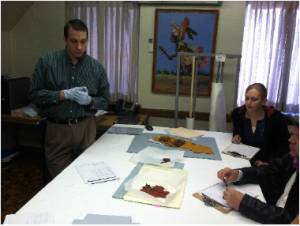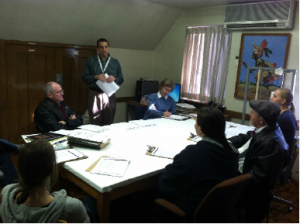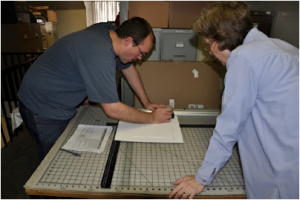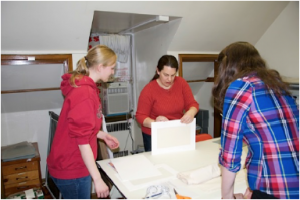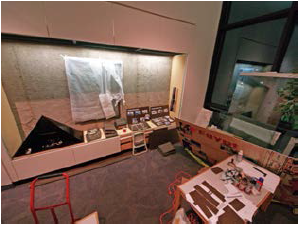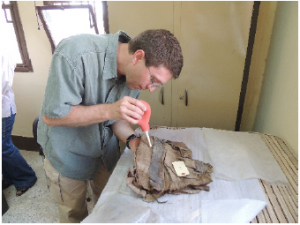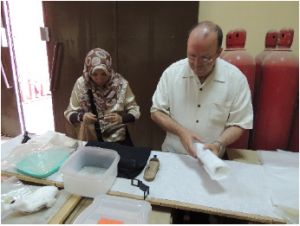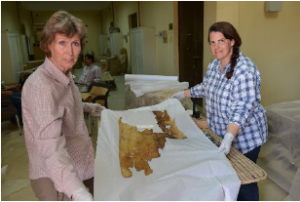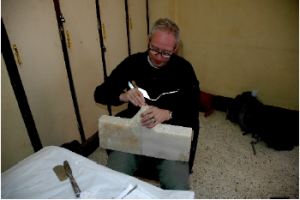Kerry Muhlestein, Lincoln Blumell and David Whitchurch, Ancient Scripture
Paul Stavast, Anthropology
Giovanni Tata, Creative Works
R Paul Evans, Microbiology and Molecular Biology
Kristin South
With the monies from the MEG granted to me and the BYU Egypt Excavation Project, we were able to accomplish wonderful things. As per our proposal, we have used the monies granted through this MEG to do conservation work in Egypt and Provo and to train students in conservation and museum skills.
We began by selecting students for whom this would be beneficial, and taking them and our team to meet with Paul Stavast, director of the Museum for Peoples and Cultures. Director Stavast provided two sessions of training in conservation and recording skills. He also provided space for us to work on the materials. Students who came on after this first meeting were trained for the beginning of the work primarily by Kristin South, who not only helped Paul in the training session, but also did a tremendous amount of conservation work in Yale’s Peabody Museum.
One of our students, Elisabeth Berghout, reported on what took place following this training:
“I was able to work primarily with the 1998 season. I also worked with the textiles for the display in the Joseph Smith Building, some of the 1994 season, and some of the 2000 season. By the beginning of the winter 2014 semester, we had finished working with the textiles we had in the Museum of Peoples and Cultures from the 1998 season. However, with some digging in storage, Kristin South and Catherine Taylor have found that there are more textiles from this season, so there is still some work to be done.
“During my mentoring time, I was taught about conservation and the careful skills necessary to clean and care for the textiles I worked with. I also learned to document them properly and to keep a record of the artifacts. In order to document each textile, I filled out two different papers.
These were Condition Reports and Textile Analysis sheets. I found that it was important to examine each textile carefully and to find and record specific details. I also did quick sketches of the textiles to identify them and to minimize the chance of future confusion and mix-ups, as we had not started taking pictures of the textiles during my time working with them.
“I had thought I was a careful and meticulous person before working on this project, but I quickly discovered that a steady hand and careful consideration were imperative in order to give the textiles the proper care necessary. As I carefully documented, cleaned, and then housed the textiles, I could see my skills grow. In order to clean the textiles, we tried to use the least invasive dry cleaning methods possible. Using screens to protect the textiles, my co-workers and I would use a vacuuming system on low settings with small nozzles to clear away the dirt and sand that had collected onto the textiles from their time buried in the desert. We moved the textiles as carefully and as little as we could, protecting them with acid free tissue paper, and storing them in linen-lined acid free mounts that we custom build for each textile.
“I think that this project was also useful to me because I was able to practice the skill of problem solving, planning, and seeing that planning come to fruition. Kristin and I worked to create several lists of the textiles so that we could see them in compiled numerical terms. We measured the textiles and made excel sheets that would help us plan the size of the mounts we needed. I also went through the field book for the 1998 season, and put that information in an excel sheet as well to record any special information about the individual burials and textiles.
“With this information, we decided to make three different standard sizes of mounts so that they would be easily stored in standard sized boxes. When we finished building the mounts, the process of placing the cleaned and documented textiles into the mounts went fairly smooth, and this was aided tremendously by our previous planning and figuring.
“During my time working on this project, several other students have participated. While Kristin did the initial training, I helped the workers with questions and technique and helped supervise them when they needed training and help. By the end, I tried to make sure that they understood how I had organized things while I was working solo during the summer and that I had passed on the necessary information for the work on this project to continue smoothly.”
The amount of work we have done is voluminous enough that it will be more efficient to present it in bullet-point fashion. During the last two years the MEG has allowed us to:
- Train 12 students in the skills of textile analysis, conservation reporting, conservation, cataloguing, and preservation.
- Train 4 students in museum display skills.
- Contribute to an exhibit by conserving and presenting 8 ancient textiles in a museum display.
- Purchase archival quality, acid-free materials in which we could store ancient artifacts.
- Use the materials to create over three hundred long term storage archival mounts for ancient artifacts.
- Clean, catalogue, photograph, and preserve over three hundred ancient artifacts
- Arrange for long-term archival storage of conserved materials with the HBLL.
- Provide an opportunity for one student to accompany 2 mentors to a conference on analyzing and conserving ancient textiles for training purposes.
- Travel to and bring archival acid free paper to Egypt where we conserved several dozen ancient textiles.
- Build acid free boxes in Egypt for long term storage of textiles there.
- Clean, record, analyze and conserve textiles in Egypt (because we cannot currently take BYU students to Egypt, we trained Egyptian students there, building very good will).
- Clean and restore a broken travertine altar in Egypt, which allowed for further analysis of it.
- Properly photograph, house, and store in acid free materials about 30 other objects in Egypt, including figurines, amulets, seeds, spindles, jewelry boxes, sandals, dice, hairpins, bracelets, earrings, and glass objects.
- Train students who major in Ancient Near Eastern Studies, Anthropology, Art History, Museum Studies, and Archaeology.
- Have a student co-author an article which has been submitted to The Journal of Late Antiquity.
- Have students submit a proposal for a poster to the upcoming Society for the Study of Egyptian Antiquities symposium in Canada.
- Hold a series of 4 lectures allowing the students we are mentoring to put their work into the context of history and current academic disciplines.
Evaluation of How the Academic Objectives Were Met
Below is a list of the originally proposed outcomes, followed by an evaluation of how well they were accomplished:
- Our students will become experts in the study of the time and culture from which our artifact collection comes. Specifically, they will understand Graeco-Roman Egypt and the role of early Christianity there.
- We trained most of the students who worked with us in these areas and they learned it well. A few of the students worked for us for a short time and did not participate in the lecture series.
- Our students will become experts in analyzing ancient textiles. They will have a high quality and quantity experience in working with mummy wrappings and other forms of textiles. They will also have some experience in working with metal and papyrus objects, as well as organic material such as grains.
- This fully happened as they worked side-by-side with experts here at BYU.
- Our students will become experts in cleaning ancient artifacts using state-of-the-art non-invasive techniques and tools.
- Many of the textiles they worked with did not need cleaning. Some did, and as they worked side-by-side with experts they received all the training necessary for this.
- Our students will become experts in what it takes to prevent artifacts from deteriorating and how to properly care and preserve them. They will actually make this happen for a high number of artifacts. Depending upon how quickly they become proficient, I believe they can work on conserving close to 100 objects, each.
- This became the focal point of the project, and was fully realized. Students conserved over 300 objects total. They worked together on most objects, so I cannot tell how many objects each individual worked with, but they all had the opportunity to work personally on conserving a high number of objects.
- We and our students will clean and conserve an important collection that will add to various studies and will preserve and enhance BYU’s reputation, rather than tarnish it.
- This has happened, and we are in the midst of publishing information about this.
- Our students will learn how to properly display museum artifacts.
- Those of our students who were with us at the beginning of the project helped to choose which objects to display and how to clean them, create mounts for them, and create the actual display. They also learned what precautions needed to be taken to make sure that objects on display were not damaged by light or other environmental conditions.
- Our students will actually display museum artifacts in a display that will be viewed by many for three years. The display will include pictures and an explanation of the role of students in our work.
- See above.
- Our students will participate in a professional conference.
- One student went with mentors to a professional conference. Three others have submitted an abstract for presenting a poster at a professional conference.
- Our students will participate in a professional presentation here on campus, hosted by the Ancient Near Eastern Studies program, the Kennedy Center, and involving Anthropology.
- This will happen at the end of the year.
- Our students will help publish a paper on these efforts.
- One student has done this; we plan on others doing this as the project winds up.
- Our students will build an important network through the consultants who will train them, through the people they work with at the conference, and through the article they will publish.
- This has happened and will happen more as they participate in a professional conference.
Evaluation of the Mentoring Environment
I believe the mentoring environment was wonderful. Many students worked with a number of faculty and staff members. Some only worked with the few that were most pertinent for the part of the project they participated in. Kristin South was the mentor that spent the most time with the students, and they benefitted greatly from her tutelage and the warm relationship she developed with them. Catherine Taylor also came onto the project partway through and had the same effect. Paul Stavast has worked with the entire team, training them in a number of aspects associated with conservation and museum studies and has created a warm and learning environment. John Gee, Lincoln Blumell, Giovanni Tata, and Paul Evans have all taught and blessed the lives of these students within an open mentoring environment. We typically trained students, then worked with them, then watched them work on their own, then let them work completely on their own with evaluative follow-up afterwards. This created a true learning environment. On the whole I think that the amount of individual time spent working with students provided them with the kind of experience typically only available to graduate students.
Students Who Participated
- Elisabeth Berghouts
- Keri Erdman
- Bethany Jensen
- Brittany Southworth
- Polly Knight
- Arthur Hatfield
- Christopher Morey
- Hattie Woods
- Taralea Forster
- Ariana Harris
- Aubrey Young
- Judith Westwood
- Aubrey Young has co-authored an article that has been submitted to The Journal of Late Antiquity.
- Keri Erdman, Polly Knight and Bethany Jensen have submitted a proposal for a poster to the upcoming Society for the Study of Egyptian Antiquities symposium in Canada.
- Bethany Jensen is working on some of these textiles as part of her senior thesis, which she and I will then rework and co-author as a professional article.
- Brian Christensen and I have submitted a report to the Egyptian Antiquities officials on the conservation work done in Egypt and are currently writing an article on two of the objects we worked on there.
Description of the Results and Finding of the Project
See above.
Description of How the Budget was Spent
- Student wages: $11,800
- Archival supplies in USA: $3850
- Travel for student and mentor to conference: $2350
- Travel to Egypt: $1300
- Archival Supplies in Egypt: $500
On the whole, we all feel that the MEG we received met with unqualified success. We have come a long way towards satisfying the wishes of the Egyptian government in using our artifacts for the training of students. We have begun to fulfill an obligation to the world and the academic community in conserving archaeological artifacts for which we are responsible. We have trained a number of students in techniques that will be very useful for them, and have provided an excellent mentoring environment that will yield a number of benefits to them.

